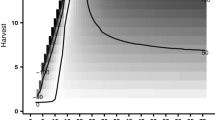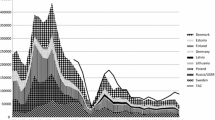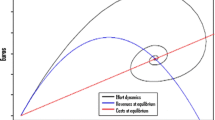Abstract
We studied cooperative and competitive solutions for managing a trans-boundary fish stock that has a stock-size dependent distribution and harvesting costs, using Norwegian spring-spawning (NSS) herring (Clupea harengus) as a case study. This is among the first studies to investigate the effect of a dynamic distribution in a partition function game framework, i.e., including externalities. The special feature of NSS herring is that it comes under the sole ownership of Norway when the stock size is sufficiently low. The three players in our game are differentiated by stock ownership, cost per unit effort and stock elasticity of harvest. We find that cost asymmetry improves the likelihood of forming a stable grand coalition as harvesting load can be assigned to each fishing zone according to a player’s relative cost level and the density of fish. A dynamic distribution increases the bargaining power of Norway because of her ability to control both the total stock and the stock shares in different zones, especially during the stock transition years. However, the bargaining power of Norway may disappear if her cost of harvesting exceeds that of the other players. This loss of bargaining power can take on two forms: first, a dynamic distribution may encourage a minor player to free ride because Norway, needing a coalition partner to improve her cost-effectiveness, would be less inclined to retaliate as retaliation hurts her ally as much as the free-rider; second, in a stable grand coalition, Norway is not guaranteed to receive an allocation of benefit shares in proportion to (not to say in excess of) her stock ownership. At the current stock condition, the strategy where Norway reduces stock abundance below the level where the stock becomes non-migratory is found attractive only if the discounting rate is sufficiently high.



Similar content being viewed by others
Notes
Shares of the herring quotas allocated to Norway, EU, Faroes, Island and Russia are 61, 6, 5, 15, and 13 %, respectively.
We allow fishermen to fish until the last fish of the fishable stock is taken. In Steinshamn’s model (2011), fishermen stop fishing when the first age class in the fishable stock becomes exhausted, even if other age classes are still present.
The fishable stock abundance, \(N_{j,t}^{tot}\), is the total stock abundance summing over all age classes with positive selectivity, i.e., \(s_i>0\).
This treatment is different from Steinshamn (2011) where he assumed \(\tau _{j,t}^e=\min _{i}(\tau _{i,j,t})\); i.e., the seasonal fishing length is determined by the age class that is exhausted first.
This classic definition has been challenged for being ‘myopic’ (de Zeeuw 2008), because it assumes that the rest of the coalition stays intact after one player deviates. Solving far-sighted equilibrium requires a different set-up, e.g., in a repeated game. For our one-shot game, the classic definition of the stability still suits the best.
We set \(c_1=2\), but its exact value is not important, the value is calibrated to a level under which fishing is generally profitable.
The boundary where fishing ceases under this circumstance is not drawn in the figure.
This would not be possible when \(c_2/c_1>1\), under which Norway becomes a dominant exploiter (see Example b in Table 2 for a proof).
The total biomass during the transition years can sometimes go below \(B_{low}\), the low biomass threshold defined in Eq. 1.
References
Arnason R, Magnusson G, Agnarsson S (2000) The Norwegian spring-spawning herring fishery: a stylized game model. Mar Resour Econ 15:293–319
Bailey M, Sumaila UR, Lindroos M (2010) Application of game theory to fisheries over three decades. Fish Res 102:1–8
Bjørndal T (1987) Production economics and optimal stock size in a North Atlantic fishery. Scand J Econ 89(2):145–164
Bjørndal T (1988) The optimal management of North Sea herring. J Environ Econ Manag 15:9–29
Bjørndal T, Gordon DV, Kaitala V, Lindroos M (2004) International management strategies for a straddling fish stock: a bio-economic simulation model of the Norwegian spring-spawning herring fishery. Environ Resour Econ 29:435–457
Brown JS, Vincent TL (1987) Coevolution as an evolutionary game. Evolution 41:66–79
Clark CW (1990) Mathematical bioeconomics: the optimal management of renewable resources, 2nd edn. Wiley, New York
D’Aspremont C, Jacquemin A, Gabszewicz JJ, Weymark JA (1983) On the stability of collusive price leadship. Can J Econ 16(1):17–25
De Clippel G, Serrano R (2008) Marginal contributions and externalities in the value. Econometrica 76(6):1413–1436
de Zeeuw A (2008) Dynamic effects on the stability of international environmental agreements. J Environ Econ Manag 55:163–174
Dieckmann U, Law R (1996) The dynamical theory of coevolution: a derivation from stochastic ecological processes. J Math Biol 34:579–612
Dragesund O, Johannessen A, Ulltang Ø (1997) Variation in migration and abundance of Norwegian spring spawning herring (Clupea harengus L.). Sarsia 82:97–105
Ekerhovd NA (2010) The stability and resilience of management agreements on climate-sensitive straddling fishery resources: the blue whiting (Micromesistius poutassou) coastal state agreement. Can J Fish Aquat Sci 67:534–552
Eyckmans J, Finus M (2004) An almost ideal sharing scheme for coalition games with externalities. Working paper no. 155.2004, Fondazione Eni Enrico Mattei, Italy. Version presented at the 7th meeting on game theory and practice dedicated to energy, environment and natural resources, May 2007, Montreal, Canada
Fuentes-Albero C, Rubio SJ (2010) Can international environmental cooperation be bought? Eur J Oper Res 202:255–264
Greenberg J (1994) Coalition structures. In: Aumann R, Hart S (eds) Handbook of game theory with applications, vol 2. North Holland, Amsterdam, pp 1305–1337
Hannesson R (2006) Sharing the herring: fish migrations, strategic advantage and climate change. In: Hannesson R (ed) Climate change and the economics of the world’s fisheries: examples of small pelagic stocks. Edward Elgar Publishing, Northampton, pp 66–99
Hannesson R (2007) Global warming and fish migrations. Nat Res Model 20:301–319
Hannesson R (2011) Game theory and fisheries. Annu Rev Resour Econ 3:181–202
Hannesson R (2013) Sharing the Northeast Atlantic mackerel. ICES J Mar Sci 70:259–269
Harley SJ, Myers RA, Dunn A (2001) Is catch-per-unit-effort proportional to abundance? Can J Fish Aquat Sci 58:1760–1772
Hilborn R, Walters CJ (1992) Quantitative fisheries stock assessment: choice, dynamics and uncertainty. Chapman and Hall, New York
Holst JC, Røttingen I, Melle W (2004) The herring. In: Skjoldal HR (ed) The Norwegian sea ecosystem. Tapir Academic Press, Trondheim, pp 203–226
ICES (2010) Report of the working group on widely distributed stocks (WGWIDE), 28 August–3 September 2010, Vigo, Spain. ICES CM 2010/ACOM:15, ICES, Copenhagen
ICES (2013) Report of the working group on widely distributed stocks (WGWIDE). 27 Aug–2 Sept 2013. ICES Headquarters, Copenhagen, Denmark. ICES CM 2013/ACCOM: 15
Johnson JE, Welch DJ (2010) Marine fisheries management in a changing climate: a review of vulnerability and future options. Rev Fish Sci 18:106–124
Kaitala V, Lindroos M (2004) When to ratify an environmental agreement: the case of high seas fisheries. Int Game Theory Rev 6:55–68
Kronbak LG, Lindroos M (2007) Sharing rules and stability in coalition games with externalities. Mar Resour Econ 22:137–154
Lindroos M (2004) Sharing the benefits of cooperation in the Norwegian spring-spawning herring fishery. Int Game Theory Rev 6:35–53
Lindroos M, Kaitala V (2000) Nash equilibria in a coalition game of the Norwegian spring-spawning herring fishery. Mar Resour Econ 15:321–339
Liu X, Heino M (2013) Comparing proactive and reactive management: managing a transboundary fish stock under changing environment. Nat Res Model 26:480–504
Liu X, Heino M (2014) Overlooked biological and economic implications of within-season fishery dynamics. Can J Fish Aquat Sci 71:181–188
Macho-Stadler I, Perez-Castrillo D, Wettstein D (2007) Sharing the surplus: an extension of the Shapley value for environments with externalities. J Econ Theory 135:339–356
Mantua NJ, Hare SR, Zhang Y et al (1997) A pacific interdecadal climate oscillation with impacts on Salmon production. Bull Am Meteorol Soc 78(6):1069–1079
McGinty M (2007) International environmental agreements among asymmetric nations. Oxf Econ Pap 59:45–62
Miller KA, Munro GR (2004) Climate and cooperation: a new perspective on the management of shared fish stocks. Mar Resour Econ 19:367–393
Norwegian Ministry of Fisheries and Coastal Affairs (2013) Firepartsavtale om forvaltning av norsk vårgytende sild. Press release 3/2013: http://www.regjeringen.no
Patterson K (1998) Biological modelling of the Norwegian spring-spawning herring stock. Fisheries Research Services, Report 1/98, Aberdeen
Perry AL, Low PJ, Ellis JR, Reynolds JD (2005) Climate change and distribution shifts in marine fishes. Science 308:1912–1915
Pham Do KH, Norde H (2007) The Shapley value for partition function form games. Int Game Theory Rev 9(2):353–360
Pintassilgo P, Finus M, Lindroos M (2010) Stability and success of regional fisheries management organizations. Environ Resour Econ 46:377–402
Planque B, Loots C, Petitgas P, Lindstr øm U, Vaz S (2011) Understanding what controls the spatial distribution of fish populations using a multi-model approach. Fish Oceanogr 20:1–17
Sandberg MG, Olafsen T (2006) Kartlegging av kompetansebehov i norsk fiskeri-og havbruksnæring. SINTEF, Trondheim
Shapley LS (1953) A value for \(n\)-person games. In: Roth A (ed) The Shapley value—essays in honor of Lloyd S. Shapley. Cambridge University Press, Cambridge, pp 31–40
Sissener EH, Bjørndal T (2005) Climate change and the migratory pattern for Norwegian spring-spawning herring-implications for management. Mar Policy 29:299–309
Sønvisen SA (2013) Recruitment to the Norwegian fishing fleet: storylines, paradoxes, and pragmatism in Norwegian fisheries and recruitment policy. Marit Stud 12:8
Steinshamn SI (2011) A conceptional analysis of dynamics and production in bioeconomic models. Am J Agric Econ 93:803–812
Thrall R, Lucas W (1963) N-person games in partition function form. Nav Res Logist Quart 10:281–298
Toresen R, Østvedt OJ (2000) Variation in abundance of Norwegian spring-spawning herring (Clupea harengus, Clupeidae) throughout the 20th century and the influence of climatic fluctuations. Fish Fish 1:231–256
Touzeau S, Lindroos M, Kaitala V, Ylikarjula J (2000) Economic and biological risk analysis of the Norwegian spring-spawning herring fishery. Ann Oper Res 94:197–217
Varpe Ø, Fiksen Ø (2010) Seasonal plankton-fish interactions: light regime, prey phenology, and herring foraging. Ecology 91:311–318
Yi S-S, Shin H (2000) Endogenous formation of research coalitions with spillovers. Int J Ind Organ 18:229–256
Author information
Authors and Affiliations
Corresponding author
Additional information
We would like to thank Mikko Heino, Stein Ivar Steinshamn, Rögnvaldur Hannesson, and Sturla F. Kvamsdal for their input and comments and Vivienne B. Knowles and Leslie Tse for language editing. We wish to thank all three anonymous referees for their constructive comments. Liu acknowledges the financial support from the Nordic network on ‘Climate impacts on fish, fishery industry and management in the Nordic seas’. Lindroos acknowledges funding from Academy of Finland AKVA programme’s project ‘Economics of Aquatic Foodwebs’.
Rights and permissions
About this article
Cite this article
Liu, X., Lindroos, M. & Sandal, L. Sharing a Fish Stock When Distribution and Harvest Costs are Density Dependent. Environ Resource Econ 63, 665–686 (2016). https://doi.org/10.1007/s10640-014-9858-9
Accepted:
Published:
Issue Date:
DOI: https://doi.org/10.1007/s10640-014-9858-9
Keywords
- Coalition game
- Dynamic stock distribution
- International resource management
- Partition function game
- Modified Shapley value




